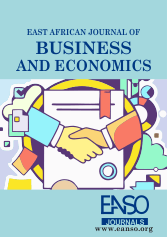Impacts of Fiscal Factors on Employment Growth in Tanzania: 1990- 2022
Abstract
This paper is based on a study examining fiscal macroeconomic factors' impacts on employment growth in Tanzania. Time series data spanning from 1990 to 2022 collected from the Bank of Tanzania and the World Bank were used. Prior to estimation, the stationarity tests were carried followed by co-integration of bound test and ARDL of long-run and short-run Error Correction Model. The findings indicated that total government revenue (ß =-0.025, P= 0.16) and inflation rate (ß = -0.002, P= 0.62) were not favorable in generating employment growth. Conversely total government expenditure ((ß = 0.01, P= 0.63), GDP growth (ß = 0.02, P= 0.06), domestic debt (ß = 0.0002, P= 0.89), and lending interest rate (ß = 0.05, P= 0.06) had a non-undesirable impact to employment growth in the long run. The study concluded that to ensure employment opportunities are generated, the government needs to increase government spending, especially on the multiplier employment projects. The study recommended, the re-examination of the government revenue and expenditure policies to ensure bases of revenue are expanded to allow more collection of revenue and the available tax revenue sources also need to favors investment in the country. To complement the newly introduced friendly tax revenue regime by the government, it is recommended that, subsidies have to be provided to the domestic projects which absorb the labour force and have the spillover effects on the economy. Friendly tax revenue bases and subsidies to the local investors will gear to higher local production, more exports that will stimulate the presence of foreign reserves and stabilize the exchange rate in the country
Downloads
References
Abdelkader, B., Cheikh, S., & Sofiane, M. (2021). The Impact of the Public Expenditure on Employment and Income in Algeria: An Empirical Investigation. American Journal of Economics, 7(3), 155- 161. https://doi.org/10.5923/j.economics.20170703.06.
Adegboye, A.C. (2020). Macroeconomic policies and sustainable employment yields in sub‐Saharan Africa. Africa Development Review, 32(4),515–527. https://doi.org/10.1111/1467-8268.12457.
Alkhateeb, T. T., Sultan, Z. A. & Mahmood, H. (2017). Oil revenue, public spending, gross domestic product and employment in Saudi Arabia. International Journal of Energy Economics and Policy (IJEEP), 7(6), 27 - 31. available at http: www.econjournals.com
Alkhateeb, T. T. Y., Mahmood, H., Sultan, Z. A & Ahmad, N. (2021). Trade Openness and Employment Nexus in Saudi Arabia. Munich Personal RePEc Archive, https://mpra.ub.uni-muenchen.de/109451/.
Attamah, N., Igwe, A., & Ukpere, W. I. (2015). The impact of fiscal and monetary policies on unemployment problem in Nigeria (Managerial economic Perspective). Risk governance & control: financial markets &institutions, 5(2), 101–109. https://doi.org/10.22495/rgcv5i2c1art4.
Awan, A.G & Qasim, H. (2020). Impact of External Debt on Economic Growth of Pakistan. Global Journal of Management, Social Sciences and Humanities, 6(1) 30-61.DOI: https://orcid.org/0000-0001-5767-6229.
Cvecic, I. & Sokolic,D. (2018). Impact of public expenditure in labour market policies and other selected factors on youth unemployment. Economic Research-, 260-280.
Dickey, D., & Fuller, W. (1979). Distribution of the estimators for autoregressive time series with a unit root. Journal of the American Statistical Association, 74: 427–431.
Engle, R.F, & Granger, C.W.J. (1987). Co-integration and Error Correction: Representation, Estimation and Testing. Econometrica, 55 (2): 251 – 279.
ILO. (2015). How do macroeconomic and sectoral policies affect employment? Retrived from https://www.google.com/How+do+macroeconomic+and+sectoral+policies+affect+employment%3F+: International Labour Office.
Islam, R. (2018). Macroeconomic Policy and Employment: A Development Pespective. The Indian Journal of Labour Economics, 61(3), 427– 451. https://doi.org/10.1007/s41027-018-0139-y.
Kamar, B., Bakardzhieva, D., & Goaied, M. (2019). Effects of pro-growth policies on employment: Evidence of regional disparities. Applied Economic, 1(40), 4337–4367. https://doi.org/10.1080/00036846.2019.1591596.
Keynes, J. M. (1936). The General Theory of Employment, Interest and Money. Havard University: Palgrave Macmillan. http://books.google.ie/books?id=Su1lDwAAQBAJ&printsec=frontcover&dq=The+General+Theory+of+Employment,+Interest+and+Money&hl=&cd=1&source=gbs_api.
Leshoro, T. A. (2013). Does Economic Growth Lead Employment in South Africa? Journal of Economics and Behavioral Studies, 5(6), 336-345.ISSN:2220-6140.
Maku,O.E. & Alimi,O.Y. (2018). Fiscal Policy Tools, Employment Generation and Sustainable Development in Nigeria. Economica, 14(3),186- 199.https://core.ac.uk/download/pdf/229460517.pdf.
Mawejje, J.& Odhiambo, N. M. (2020). FIscal Reforms and Deficits in Tanzania:An Exploratory Review. Sciendo, 30(1) 57 -75. DOI: 10.2478/sues-2020-0004
Micheni, P. N. & Muturi, W. (2019). Effect of macroeconomic variables on unemployment in Kenya. The Strategic Journal of Business & Change Management, 6(2), 1578 –5961, https://doi.org/10.61426/sjbcm.v6i2.1205.
Mwamkonko, M. A. (2023). Macroeconomic Stabilization Effects of Public Expenditures: Empirical Evidence from Tanzania. Journal of African Economic Perspectives, 1(1), 1–18. https://doi.org/10.58548/2023jaep11.0118.
Omran, E.A.M.& Bilan, Y. (2020). “The Impact of Fiscal Policy on the Unemployment Rate". Montenegrin Journal of Economics, 16(4) ,199-209.DOI:10.14254/1800-5845/2020.16-4.16.
Onifade, S. T., Ay, A., Asongu, S.& Bekun, F.V. (2020). Revisiting the trade and unemployment nexus: Empirical evidence from the Nigerian economy. Journal of Public Affairs, 20(3). https://doi.org/10.1002/pa.2053
Onwuka, C. E. (2021). The impact of fiscal and monetary policy on unemployment rate in Nigeria. SSRN Electronic Journal., https://doi.org/10.2139/ssrn.3959996.
Pesaran, M. H., Shin,Y. & Smith, R.J. (2001). Bounds testing approaches to the analysis of level relationships. Journal of applied econometrics, 16(3):289-326. https://doi.org/10.1002/jae.616.
Phipps, A. J., & Sheen, J. R. (1995). Macroeconomic Policy and Employment Growth in Australia. The Australian Economic Review, 28(1), 86–104. https://doi.org/10.1111/j.1467-8462.1995.tb00877.x.
Sanjo, G.J., Sende, N.B. & Mpeta, I.F. (2022). Effect of Trade Openness and Real Exchange Rate on Economic Growth in Tanzania. Journal of Economics, Management and Trade, 28(7) 47- 64. https://www.sdiarticle5.com/review-history/87121.
URT. (2010). The Tanzania Mainland's 50 Years of Independence: A Review of the Role and Functions of the Bank of Tanzania (1961-2011). Dar Es Salaam: Bank Of Tanzania.
URT. (2021). Intergrated labour force survey 2020/21 analytical report. https://www.nbs.go.tz/index.php/en/census-surveys/labour-statistics/688-integrated-labour-force-survey-2020-21.
URT. (2023). Annual Report 2022/23. Dar es Salaam: Bank of Tanzania.
URT. (2024). Monetary Policy Framework. Dar es Salaam. https://www.bot.go.tz/MPS: Bank of Tanzania.
World Bank. (2023). World development indicators database. Washington, DC https://databank.worldbank.org/source/world-development-indicators: World Bank.
Yusuf, S. & Omar, M. R. (2019). Trade openness and economic growth of Tanzania. Resaerch Gate, 12(3) 1- 10.DOI: 10.9734/ajeba/2019/v12i330154.
Copyright (c) 2024 Rehema Ramadhan Mhenwa, Deus Dominic Ngaruko, Timothy Lyanga

This work is licensed under a Creative Commons Attribution 4.0 International License.




























